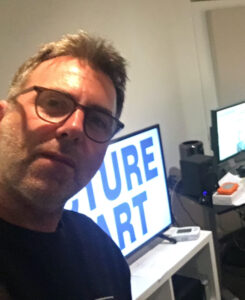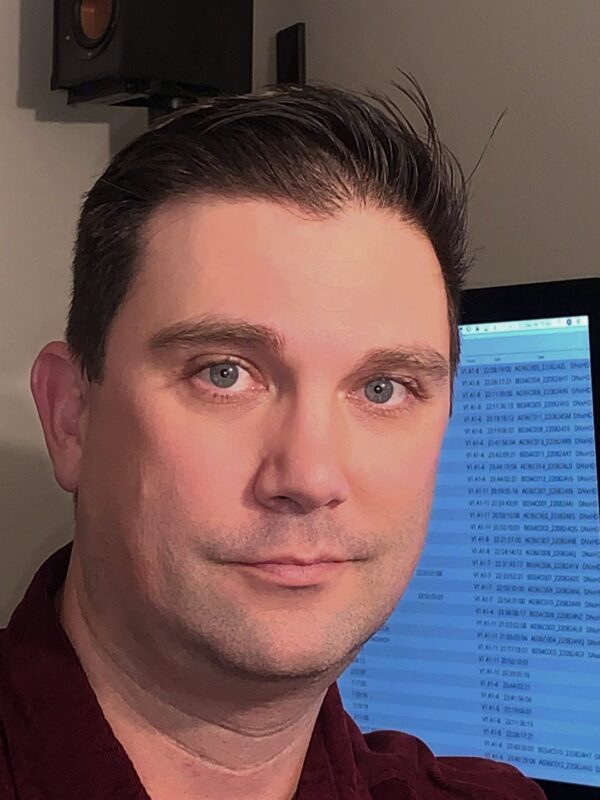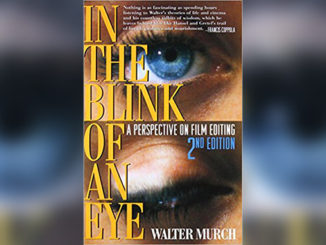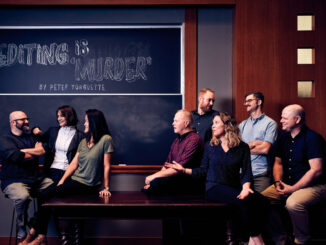
By Rob Feld
The editing team of “Shantaram” faced a mammoth task: How to cut a sprawling TV serialization of Gregory David Roberts’ acclaimed 944-page novel.
Luckily, that team — Geraud Brisson, Fabienne Bouville, and Tim Mirkovich — was up to the challenge.
Overseen by Steve Lightfoot and Eric Warren Singer, the Apple TV+ series tracks the redemption of Australian fugitive Lin Ford (Charlie Hunnam), who escapes from prison and seeks to disappear in 1980s Mumbai. It doesn’t take long for him to be ensconced in the city’s underworld of locals and nefarious expats, trying to learn its rules while finding a place for himself. In so doing, he befriends his street guide, Prabhu (Shubham Saraf) and falls in love with Karla (Antonia Desplat), who respectively come to represent Lin’s spiritual and intellectual connections to the unique city. Lin sprints irrepressibly toward trouble and finds himself in the middle of a conspiracy, caught between freedom and love, and choices between.
The international production, shooting between countries with its editing team back in the U.S., left Brisson, Bouville, and Mirkovich with a sense of Showrunner Lightfoot’s vision but no other guidance while they were first trying to identify the voice of the stylish show, not to mention the geography of Mumbai. Close collaboration helped, but the team credits some success to the way their episodes were assigned in blocks rather than being staggered, giving them an ownership and consistency that they found to be unique.
Edited conversation follows:
CineMontage: What were you told when you came on board and how did you apply it to finding the show’s voice?
Geraud Brisson: I cut the first block of three episodes. When I first met with Steve Lightfoot and Bharat Nalluri, who directed those first three episodes, they mentioned a few references, one of which was “Trainspotting.” They wanted that energy and rush. Interestingly, that didn’t work when we tried to emulate it too closely because we wanted to make something believable and heartfelt, too.
Fabienne Bouville: You couldn’t have it be too stylized without losing the characters, but you could still have moments of fun with the cutting, sound, and music. It’s a heavily plotted show with lots going on, so everything does have to be clear. But it’s Lin’s huge heart that gets him in trouble because he doesn’t have any boundaries. He gets involved everywhere. You wanted to make sure that that feeling translated.
Geraud Brisson: We were juggling a thriller, a love story, and the friendship at the heart of Lin’s journey of self-discovery, change, and redemption. Once we added those elements, they guided us to find the tone and voice.

Tim Mirkovich: I edited the third block of episodes, so I had the luxury of coming in after production had already started. Going into it, my biggest challenge was, how to create Mumbai in the 1980’s without being over the top, unrealistic? Fortunately, Geraud and Fabienne had established that for me to some extent, so I was able to take hints and guides from them and keep going with it.
Fabienne Bouville: I was actually in Mumbai in the ’80s as a young high school kid. How it felt was still vivid in my mind. For me, the sound was very important. A lot of the show is shot against blue screen so the sound we had was really what put me in the place. My memories of Mumbai was as a crowded, chaotic, constant jostling place. So, I leaned on that. Then in conversations, Steve talked about bringing heart and fun to the rhythm of the series.
Geraud Brisson: It’s a world seen through Lin’s eyes so in the first few episodes it was about a sense of release for him, and a discovery of a world that could be home for somebody on the run. That was helpful when starting with a scene between him and Prabhu, who becomes his best friend in Mumbai. That really set up the heart for me and was when I started to get a sense of what “Shantaram” should be or could be.
CineMontage: Were cuts implicit in the footage you received or was there a lot of leeway for you?
Tim Mirkovich: The footage definitely gave us options. I had several scenes where I had 48 hours of footage from two days and four cameras capturing a hundred extras and giant fights in the slum. But then I’d also have scenes that were five to seven-minute monologues in Hindi. Stylistically, I tended to use a lot of medium and wide shots and then punch in close. We could have turned this show into anything, but they did a great job with the early episodes to find the balance of fun, tension, love, and heartbreak. I think we found that balance because they gave us the option to find where it should live.
CineMontage: It was a big international shoot without you being on location. How did that affect your work, do you think?
Fabienne Bouville: We were working for months while they were shooting, with no input from them to find the way. We were all following Steve’s vision but within that, there was a lot of freedom to figure out how to best express that vision. The blue screen ultimately gave us some freedom in the backend because if we found a scene was missing something, we could get it into the background.
Geraud Brisson: The show was shot in multiple places: India, Australia, Thailand, but we also had some footage from India that had been shot by another team. As always, you can get a significant amount of footage and it’s not always clear how you should put it together. At first, like Fabienne said, we were not always in touch with our directors or our showrunner because they were away with a 17-hour time difference. But Steve Lightfoot is ultimately very collaborative in the cutting room, likes the process, and comes in with an open mind. We had ambient sound from India, which was very useful because a complete outsider like me could hear the streets. Then the additional footage we got from the units in India was an inspiration—I think because I cut the first episode and tried to set up this world early on, I eventually had to use more of it than Tim and Fabian.
CineMontage: They had sets but your visual effects department was building set extensions and backgrounds?

Tim Mirkovich: We had to take our set extensions and place them into a real place so there were lots of discussions with VFX. Our production designer came up with these amazing maps of Mumbai, showing where everything should be. In order to then place our sets into the real world, there were tons of meetings and discussions and very long nightly zoom calls about the locations and where a set would live. Then there was the practicality of them needing to go shoot it. You can’t block off streets in India so there was definitely a practical side of what was realistic to shoot. I think we can all attest to the fantastic job the visual effects team did to create the realism that the show deserved.
Fabienne Bouville: On top of it all, we had to make it 1982 so they couldn’t just shoot backgrounds. I had an episode where Lin goes from the slum to a leper colony outside of Mumbai. All I had was him on a motorcycle with Abdullah. I remember looking at a map and changing the sound to make each shot a new location—a construction site, deep in city, then to the outskirts, and then the leopard colony. I remember getting the plates from India, placing them and finding a cow in there to get a sense of the place.
Geraud Brisson: We also found footage Mumbaishot during the 2020 lockdown, which had anunusually small number of vehicles and people in the street for a city like Mumbai. It helped visual effects, so they didn’t have to remove as many elements to make it look like the ’80’s.

CineMontage: Tell me more about working with blocks of episodes.
Fabienne Bouville: It was very helpful to work in blocks. I did episodes Four, Five, and Six. I familiarized myself with what happened before and after but within those, I had a close sense of the arcs within my episodes, which is unusual. Usually, you’re jumping around within the series. The overall arc is in the hands of the showrunner and I trust that, but I felt more control over my block and the ability to move some things around if needed.
Geraud Brisson: I did the first three and the last three episodes. It was challenging but I also felt like we had more ownership of big story arcs. Steve is great and he’d lived with this project for so long, he was very clear about what his intentions were, and to not lose track of them through the process. That being said, we did move things from one block of episodes to another when necessary. It was 12 episodes and we had to not just keep an eye on plot but on the character study.
Tim Mirkovich: Each having a block of consecutive episodes to cut, and each block having a different director, was a unique aspect of the show. I approached it as if we were all cutting little features. Having that freedom to see a bigger picture helped and I did move multiple pieces from one episode to another. I think that process helped the show. You don’t get that ability when you are cutting every other episode in a series. I would love to do it again.






